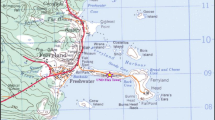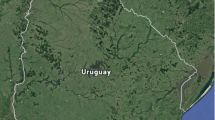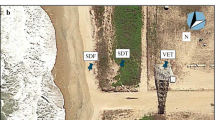Abstract
Atmospheric turbulence measurements made at the U.S. Army Corps of Engineers Field Research Facility (FRF) located on the Atlantic coast near the town of Duck, North Carolina during the CASPER-East Program (October–November 2015) are used to study air–sea/land coupling in the FRF coastal zone. Turbulence and mean meteorological data were collected at multiple levels (up to four) on three towers deployed at different landward distances from the shoreline, with a fourth tower located at the end of a 560-m-long FRF pier. The data enable comparison of turbulent fluxes and other statistics, as well as investigations of surface-layer scaling for different footprints, including relatively smooth sea-surface conditions and aerodynamically rough dry inland areas. Both stable and unstable stratifications were observed. The drag coefficient and diurnal variation of the sensible heat flux are found to be indicators for disparate surface footprints. The drag coefficient over the land footprint is significantly greater, by as much as an order of magnitude, compared with that over the smooth sea-surface footprint. For onshore flow, the internal boundary layer in the coastal zone was either stable or (mostly) unstable, and varied dramatically at the land-surface discontinuity. The offshore flow of generally warm air over the cooler sea surface produced a stable internal boundary layer over the ocean surface downstream from the coast. While the coastal inhomogeneities violate the assumptions underlying Monin–Obukhov similarity theory (MOST), any deviations from MOST are less profound for the scaled standard deviations and the dissipation rate over both water and land, as well as for stable and unstable conditions. Observations, however, show a poor correspondence with MOST for the flux-profile relationships. Suitably-averaged, non-dimensional profiles of wind speed and temperature vary significantly among the different flux towers and observation levels, with high data scatter. Overall, the statistical dependence of the vertical gradients of scaled wind speed and temperature on the Monin–Obukhov stability parameter in the coastal area is weak, if not non-existent.















Similar content being viewed by others
References
Alappattu DP, Wang Q, Yamaguchi R, Lind RJ, Reynolds M, Christman AJ (2017) Warm layer and cool skin corrections for bulk water temperature measurements for air-sea interaction studies. J Geophys Res Oceans 122(C8):6470–6481. https://doi.org/10.1002/2017JC012688
Andreas EL (2002) Parameterizing scalar transfer over snow and ice: a review. J Hydrometeorol 3(4):417–432
Atkinson BW, Zhu M (2005) Radar-duct and boundary-layer characteristics over the area of The Gulf. Q J R Meteorol Soc 131(609A):1923–1953. https://doi.org/10.1256/qj.04.113
Babić K, Rotach MW, Klaić ZB (2016a) Evaluation of local similarity theory in the wintertime nocturnal boundary layer over heterogeneous surface. Agric For Meteorol 228–229:164–179. https://doi.org/10.1016/j.agrformet.2016.07.002
Babić N, Večenaj Ž, De Wekker SFJ (2016b) Flux-variance similarity in complex terrain and its sensitivity to different methods of treating non-stationarity. Boundary-Layer Meteorol 159(1):123–145. https://doi.org/10.1007/s10546-015-0110-0
Brooks IM (2001) Air-sea interaction and spatial variability of the surface evaporation duct in a coastal environment. Geophys Res Lett 28(10):2009–2012. https://doi.org/10.1029/2000GL012751
Brooks IM, Goroch AK, Rogers DP (1999) Observations of strong surface radar ducts over the Persian Gulf. J Appl Meteorol 38(9):1293–1310
Burba G (2013) Eddy covariance method for scientific, industrial, agricultural and regulatory applications: a field book on measuring ecosystem gas exchange and areal emission rates. LI-COR Biosciences, Lincoln, USA, 331 p. ISBN: 978-0-61576827-4
Businger JA, Wyngaard JC, Izumi Y, Bradley EF (1971) Flux-profile relationships in the atmospheric surface layer. J Atmos Sci 28:181–189
Coceal O, Belcher SE (2004) A canopy model of mean winds through urban areas. Q J R Meteorol Soc 130(599):1349–1372. https://doi.org/10.1256/qj.03.40
Dolan R, Lins HF (1986) The outer banks of North Carolina. U.S. Geological Survey Professional Paper 1177-B, 49 p. https://doi.org/10.3133/pp1827, https://pubs.usgs.gov/pp/1177b/report.pdf
Dolan R, Lins HF, Smith JJ (2016) The outer banks of North Carolina. U.S. Geological Survey Professional Paper 1827, 153 p. https://doi.org/10.3133/pp1827, https://pubs.er.usgs.gov/publication/pp1827
Dyer AJ (1974) A review of flux-profile relationships. Boundary-Layer Meteorol 7:363–372
Fairall CW, Bradley EF, Hare JE, Grachev AA, Edson JB (2003) Bulk parameterization of air-sea fluxes: updates and verification for the COARE algorithm. J Clim 16(4):571–591
Fairall CW, Bariteau L, Grachev AA, Hill RJ, Wolfe DE, Brewer WA, Tucker SC, Hare JE, Angevine WM (2006) Turbulent bulk transfer coefficients and ozone deposition velocity in the International Consortium for Atmospheric Research into Transport and Transformation. J Geophys Res 111(D23):D23S20. https://doi.org/10.1029/2006JD007597
Friebel HC, Hanson JL, Benilov AY, Resio DT (2009) Long-term drag coefficient measurements in the coastal zone. In: 11th international workshop on hindcasting and forecasting and 2nd coastal hazard symposium. Halifax, NS, Canada, October 18–23, 2009, JCOMM Technical Report 52, WMO/TD-No. 1533, IOC Workshop Report 232. http://www.waveworkshop.org/11thWaves/Papers/FriebelEtAl_Halifax_1Oct09.pdf
Garratt JR (1987) The stably stratified internal boundary-layer for steady and diurnally varying offshore flow. Boundary-Layer Meteorol 38(4):369–394. https://doi.org/10.1007/BF00120853
Garratt JR (1990) The internal boundary-layer: a review. Boundary-Layer Meteorol 50(1):171–203. https://doi.org/10.1007/BF00120524
Garratt JR (1992) The atmospheric boundary layer. Cambridge University Press, Cambridge
Garratt JR, Ryan BF (1989) The structure of the stably stratified internal boundary-layer in offshore flow over the sea. Boundary-Layer Meteorol 47(1):17–40. https://doi.org/10.1007/BF00122320
Geernaert GL (1988) Drag coefficient modelling for the near-coastal zone. Dyn Atmos Oceans 11(3–4):307–322. https://doi.org/10.1016/0377-0265(88)90004-8
Geernaert GL (2002) On extending the flux-profile similarity theory to include quasi-homogeneous conditions in the marine atmospheric surface layer. Boundary-Layer Meteorol 105(3):433–450. https://doi.org/10.1023/A:1020307703242
Geernaert GL (2007) On the evaporation duct for inhomogeneous conditions in coastal regions. J Appl Meteorol Climatol 46(4):538–543. https://doi.org/10.1175/JAM2481.1
Geernaert GL (2010) Normalizing air-sea flux coefficients for horizontal homogeneity, stationarity, and neutral stratification. J Phys Oceanogr 40(9):2148–2158. https://doi.org/10.1175/2010JPO4407.1
Glazunov A, Rannik Ü, Stepanenko V, Lykosov V, Auvinen M, Vesala T, Mammarella I (2016) Large-eddy simulation and stochastic modeling of Lagrangian particles for footprint determination in the stable boundary layer. Geosci Model Dev 9:2925–2949. https://doi.org/10.5194/gmd-9-2925-2016
Grachev AA, Fairall CW, Larsen SE (1998) On the determination of the neutral drag coefficient in the convective boundary layer. Boundary-Layer Meteorol 86(2):257–278. https://doi.org/10.1023/A:1000617300732
Grachev AA, Fairall CW, Persson POG, Andreas EL, Guest PS, Jordan RE (2003) Turbulence decay in the stable arctic boundary layer. In: American Meteorological Society, seventh conference on polar meteorology and oceanography and joint symposium on high-latitude climate variations. 12–16 May 2003, Hyannis MA, Paper 3.12. http://ams.confex.com/ams/7POLAR/techprogram/paper_61456.htm
Grachev AA, Fairall CW, Persson POG, Andreas EL, Guest PS (2005) Stable boundary-layer scaling regimes: the SHEBA data. Boundary-Layer Meteorol 116(2):201–235. https://doi.org/10.1007/s10546-004-2729-0
Grachev AA, Andreas EL, Fairall CW, Guest PS, Persson POG (2008) Turbulent measurements in the stable atmospheric boundary layer during SHEBA: ten years after. Acta Geophys 56(1):142–166. https://doi.org/10.2478/s11600-007-0048-9
Grachev AA, Bariteau L, Fairall CW, Hare JE, Helmig D, Hueber J, Lang EK (2011) Turbulent fluxes and transfer of trace gases from ship-based measurements during TexAQS 2006. J Geophys Res 116(D13):D13110. https://doi.org/10.1029/2010JD015502
Grachev AA, Andreas EL, Fairall CW, Guest PS, Persson POG (2013) The critical Richardson number and limits of applicability of local similarity theory in the stable boundary layer. Boundary-Layer Meteorol 147(1):51–82. https://doi.org/10.1007/s10546-012-9771-0
Grachev AA, Andreas EL, Fairall CW, Guest PS, Persson POG (2015) Similarity theory based on the Dougherty-Ozmidov length scale. Q J R Meteorol Soc 141(690A):1845–1856. https://doi.org/10.1002/qj.2488
Grachev AA, Leo LS, Di Sabatino S, Fernando HJS, Pardyjak ER, Fairall CW (2016) Structure of turbulence in katabatic flows below and above the wind-speed maximum. Boundary-Layer Meteorol 159(3):469–494. https://doi.org/10.1007/s10546-015-0034-8
Högström U (1988) Non-dimensional wind and temperature profiles in the atmospheric surface layer: a re-evaluation. Boundary-Layer Meteorol 42(1):55–78. https://doi.org/10.1007/BF00119875
Horst TW, Weil JC (1992) Footprint estimation for scalar flux measurements in the atmospheric surface layer. Boundary-Layer Meteorol 59(3):279–296. https://doi.org/10.1007/BF00119817
Horst TW, Weil JC (1994) How far is far enough?: The fetch requirements for micrometeorological measurement of surface fluxes. J Atmos Ocean Techol 11(4):1018–1025
Johansson C, Smedman A-S, Högström U, Brasseur JG, Khanna S (2001) Critical test of the validity of Monin–Obukhov similarity during convective conditions. J Atmos Sci 58(12):1549–1566
Kaimal JC, Finnigan JJ (1994) Atmospheric boundary layer flows: their structure and measurements. Oxford University Press, Oxford
Katsaros KB, Smith SD, Oost WA (1987) HEXOS: Humidity Exchange over the Sea, a program for research on water-vapor and droplet fluxes from sea to air at moderate to high wind speeds. Bull Am Meteorol Soc 68(5):466–476
Klaassen W, Sogachev A (2006) Flux footprint simulation downwind of a forest edge. Boundary-Layer Meteorol 121(3):459–473. https://doi.org/10.1007/s10546-006-9078-0
Kljun N, Calanca P, Rotach MW, Schmid HP (2004) A simple parameterisation for flux footprint predictions. Boundary-Layer Meteorol 112(3):503–523. https://doi.org/10.1023/B:BOUN.0000030653.71031.96
Kljun N, Calanca P, Rotach MW, Schmid HP (2015) A simple two-dimensional parameterisation for flux footprint prediction (FFP). Geosci Model Dev 8:3695–3713. https://doi.org/10.5194/gmd-8-3695-2015
Klipp C (2007) Wind direction dependence of atmospheric boundary layer turbulence parameters in the urban roughness sublayer. J Appl Meteorol Climatol 46(12):2086–2097. https://doi.org/10.1175/2006JAMC1298.1
Kormann R, Meixner FX (2001) An analytical footprint model for non-neutral stratification. Boundary-Layer Meteorol 99(2):207–224. https://doi.org/10.1023/A:1018991015119
Leclerc MY, Foken T (2014) Footprints in micrometeorology and ecology. Springer, Berlin. https://doi.org/10.1007/978-3-642-54545-0
Mahrt L (1996) The bulk aerodynamic formulation over heterogeneous surfaces. Boundary-Layer Meteorol 78(1–2):87–119. https://doi.org/10.1007/BF00122488
Mahrt L (1999) The coastal zone. In: Geernaert GL (ed) Air-sea exchange: physics, chemistry and dynamics. Kluwer Academic Publishers, Dordrecht, pp 247–268
Mahrt L, Vickers D, Howell J, Højstrup J, Wilczak JM, Edson J, Hare J (1996) Sea surface drag coefficients in the Risø Air Sea experiment. J Geophys Res 101(C6):14,327–14,335. https://doi.org/10.1029/96JC00748
Mahrt L, Vickers D, Edson J, Sun J, Højstrup J, Hare J, Wilczak JM (1998) Heat flux in the coastal zone. Boundary-Layer Meteorol 86(3):421–446. https://doi.org/10.1023/A:1000784219817
Mahrt L, Vickers D, Edson J, Wilczak JM, Hare J, Højstrup J (2001a) Vertical structure of turbulence in offshore flow during RASEX. Boundary-Layer Meteorol 100(1):47–61. https://doi.org/10.1023/A:1018982828967
Mahrt L, Vickers D, Sun J, Crawford TL, Crescenti G, Frederickson P (2001b) Surface stress in offshore flow and quasi-frictional decoupling. J Geophys Res 106(D18):20629–20639. https://doi.org/10.1029/2000JD000159
Mahrt L, Andreas EL, Edson JB, Vickers D, Sun J, Patton EG (2016) Coastal zone surface stress with stable stratification. J Phys Oceanogr 46(1):95–105. https://doi.org/10.1175/JPO-D-15-0116.1
Monin AS, Obukhov AM (1954) Basic laws of turbulent mixing in the surface layer of the atmosphere. Trudy Geofiz Inst Acad Nauk SSSR 24(151):163–187
Monin AS, Yaglom AM (1971) Statistical fluid mechanics: mechanics of turbulence, vol 1. MIT Press, Cambridge
Nadeau DF, Pardyjak ER, Higgins CW, Parlange MB (2013) Similarity scaling over a steep alpine slope. Boundary-Layer Meteorol 147(3):401–419. https://doi.org/10.1007/s10546-012-9787-5
Obukhov AM (1946) Turbulence in an atmosphere with a non-uniform temperature. Trudy Inst Teoret Geofiz Akad Nauk SSSR 1:95–115 (translation in: Boundary-Layer Meteorol, 1971, 2:7–29)
Panofsky HA, Dutton JA (1984) Atmospheric turbulence: models and methods for engineering applications. Wiley, New York
Panofsky HA, Tennekes H, Lenschow DH, Wyngaard JC (1977) The characteristics of turbulent velocity components in the surface layer under convective conditions. Boundary-Layer Meteorol 11(3):355–361. https://doi.org/10.1007/BF02186086
Rannik Ü (1998) On the surface layer similarity at a complex forest site. J Geophys Res 103(D8):8685–8697. https://doi.org/10.1029/98JD00086
Smedman A-S, Bergström H, Högström U (1995) Spectra, variances and length scales in a marine stable boundary layer dominated by a low level jet. Boundary-Layer Meteorol 76(3):211–232. https://doi.org/10.1007/BF00709352
Smedman A-S, Bergström H, Grisogono B (1997a) Evolution of stable internal boundary layers over a cold sea. J Geophys Res 102(C1):1091–1099. https://doi.org/10.1029/96JC02782
Smedman A-S, Högström U, Bergström H (1997b) The turbulence regime of a very stable marine airflow with quasi-frictional decoupling. J Geophys Res 102(C9):21,049–21,059. https://doi.org/10.1029/97JC01070
Smith SD, Anderson RJ, Oost WA, Kraan C, Maat N, DeCosmo J, Katsaros K, Davidson KL, Bumke K, Hasse L, Chadwick HM (1992) Sea surface wind stress and drag coefficients: the HEXOS results. Boundary-Layer Meteorol 60(1–2):109–142. https://doi.org/10.1007/BF00122064
Sorbjan Z (1989) Structure of the atmospheric boundary layer. Prentice-Hall, Englewood Cliffs
Stiperski I, Rotach MW (2016) On the measurement of turbulence over complex mountainous terrain. Boundary-Layer Meteorol 159(1):97–121. https://doi.org/10.1007/s10546-015-0103-z
Stull RB (1988) An introduction to boundary-layer meteorology. Kluwer Academic Publishers, Boston
Sun J, Vandemark D, Mahrt L, Vickers D, Crawford T, Vogel C (2001) Momentum transfer over the coastal zone. J Geophys Res 106(D12):12,437–12,448. https://doi.org/10.1029/2000JD900696
Vickers D, Mahrt L (1997) Fetch limited drag coefficients. Boundary-Layer Meteorol 85(1):53–79. https://doi.org/10.1023/A:1000472623187
Vickers D, Mahrt L (1999) Observations of non-dimensional wind shear in the coastal zone. Q J R Meteorol Soc 125(559A):2685–2702. https://doi.org/10.1002/qj.49712555917
Vickers D, Mahrt L (2010) Sea-surface roughness lengths in the midlatitude coastal zone. Q J R Meteorol Soc 136(649B):1089–1093. https://doi.org/10.1002/qj.617
Vickers D, Mahrt L, Sun J, Crawford T (2001) Structure of offshore flow. Mon Weather Rev 129(5):1251–1258
Wang Q, Alappattu DP, Billingsley S, Blomquist B, Burkholder RJ, Christman AJ, Creegan ED, de Paolo T, Eleuterio DP, Fernando HJS, Franklin KB, Grachev AA, Haack T, Hanley TR, Hocut CM, Holt TR, Horgan K, Jonsson HH, Hale RA, Kalogiros JA, Khelif D, Leo LS, Lind RJ, Lozovatsky I, Panella-Morato J, Mukherjee S, Nuss WA, Pozderac J, Rogers LT, Savelyev I, Savige DK, Shearman RK, Shen L, Terrill E, Ulate AM, Wang Q, Wendt RT, Wiss R, Woods RK, Xu L, Yamaguchi RT, Yardim C (2017) CASPER: coupled air-sea processes and electromagnetic (EM) wave ducting research. Bull Am Meteorol Soc https://doi.org/10.1175/BAMS-D-16-0046.1
Wilson JD (2008) Monin-Obukhov functions for standard deviations of velocity. Boundary-Layer Meteorol 129(3):353–369. https://doi.org/10.1007/s10546-008-9319-5
Wilson JD (2015) Computing the flux footprint. Boundary-Layer Meteorol 156(1):1–14. https://doi.org/10.1007/s10546-015-0017-9
Wood CR, Lacser A, Barlow JF, Padhra A, Belcher SE, Nemitz E, Helfter C, Famulari D, Grimmond CSB (2010) Turbulent flow at 190 m height above London during 2006–2008: a climatology and the applicability of similarity theory. Boundary-Layer Meteorol 137(1):77–96. https://doi.org/10.1007/s10546-010-9516-x
Wyngaard JC (2010) Turbulence in the atmosphere. Cambridge University Press, New York
Acknowledgements
The CASPER Program was funded by the Office of Naval Research (ONR) under its Multidisciplinary University Research Initiative (MURI) program, Grant N0001416WX00469 to NPS and Grant N00014-17-1-3195 to University of Notre Dame, with program managers Dr. Daniel Eleuterio and Dr. Steve Russell. We thank all the researchers who organized, deployed, operated, and maintained the instruments that have provided the in situ measurements during the CASPER-East field campaign. Their efforts are greatly appreciated.
Author information
Authors and Affiliations
Corresponding author
Rights and permissions
About this article
Cite this article
Grachev, A.A., Leo, L.S., Fernando, H.J.S. et al. Air–Sea/Land Interaction in the Coastal Zone. Boundary-Layer Meteorol 167, 181–210 (2018). https://doi.org/10.1007/s10546-017-0326-2
Received:
Accepted:
Published:
Issue Date:
DOI: https://doi.org/10.1007/s10546-017-0326-2




